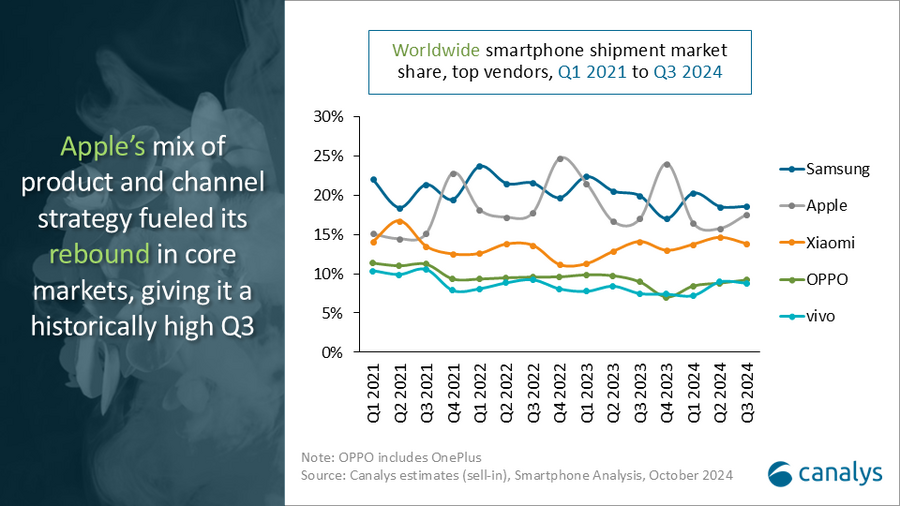
Samsung led the global smartphone market with 57.5 million shipments, bolstered by a streamlined entry-level lineup, whereas Apple retained second place with a record 54.5 million units, driven by the iPhone 16 series’ strong debut in emerging markets from narrower hardware gaps between base and Pro models, found a new study by Canalys.
The global smartphone shipments, according to the study, grew 5% year on year in Q3 2024, reaching 309.9 million units, the strongest Q3 performance since 2021. This surge was fuelled by aggressive launches from smartphone brands offering refreshed portfolios with strong value propositions, encouraging upgrade numbers amid a favourable refresh cycle and robust consumer sentiment, said the study.
Xiaomi held third spot with 42.8 million units and a 14% market share, benefiting from strategic inventory positioning for new launches in core markets. OPPO and vivo finished the top five, shipping 28.6 million and 27.2 million units, respectively, with healthy performances in the highly competitive Asia Pacific region, according to the study.
Le Xuan Chiew, an analyst at Canalys, said, “Apple achieved record Q3 shipments, driven by a strategic blend of channel and supply chain optimizations.” Post-WWDC’s Apple Intelligence announcements, he said, “The consumers are actively upgrading from older iPhone 12 and 13 models to embrace this new technology. Moreover, Apple’s diversified iPhone production, notably in India, has significantly reduced lead times, streamlining pre-order fulfilment and stimulating local demand through competitive pricing.”

“Supplementary production of previous-generation iPhones, such as the iPhone 13 and 15, in India has further bolstered Apple’s operator channel shipments into the US and Europe, enabling it to reclaim market share in the mid-range segment and capitalize on replacement demand. Nevertheless, it is vital to note the geopolitical obstacles, and the delayed deployment of Apple Intelligence may substantially hinder Apple’s performance both in the festive fourth quarter and in 2025,” added Chiew.
Canalys Senior Analyst Toby Zhu said, “Intense competition in the low-end market has persisted, despite a strong first half of 2024 buoyed by robust consumer demand and favourable economic conditions.”
“OPPO’s successful launch of the rebranded A3 series in the US$100-to-US$200 price segment, particularly in Southeast Asia, is a prime example of this strategy. By streamlining its portfolio, OPPO has seen 30% year-on-year growth in the region and is poised to further increase its market share. But rising component costs and channel saturation pose challenges to long-term profitability and the sustainability of mass-market strategies. To address these challenges, brands are expanding their focus to mid-tier growth in emerging markets,” said Zhu.
“In the second half of 2024, Xiaomi is leveraging its strong open market presence and brand stores to elevate its mid-to-high-end sales and redirect consumer demand toward its Pro series. Meanwhile, vivo expanded its V40 series to cover a wider range of variants to boost its mid-range offerings,” added Zhu.
Chiew said Canalys remains cautiously optimistic for the rest of the year, with vendors sharpening inventory positioning and brand building to fuel growth into 2025
“Emerging markets, such as Southeast Asia and Latin America, have outperformed the overall market, driven by increased price competition and channel incentives in the entry-level segment. While this segment remains vital for volume and market share, inflationary pressures limit the profitability of ultra-low-end devices, making sustained price wars challenging,” said Chiew.
Chiew further said, “In mature markets, such as the US, China and Western Europe, premium segment growth will be driven by AI-powered differentiation. Vendors such as vivo and HONOR are expanding their mid-range portfolios through innovative channel strategies, including pop-up stores and operator partnerships, to capture upgraders from the US$100-to-US$200 price band.”
See What’s Next in Tech With the Fast Forward Newsletter
Tweets From @varindiamag
Nothing to see here - yet
When they Tweet, their Tweets will show up here.





























